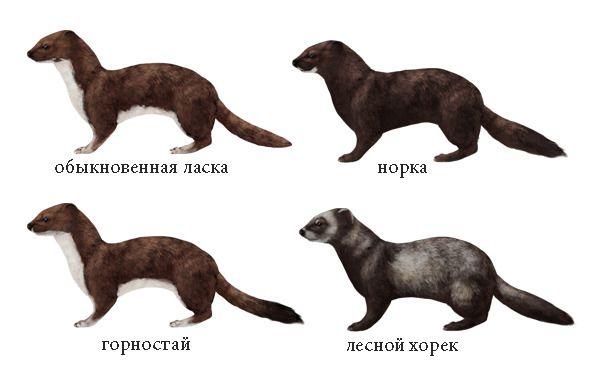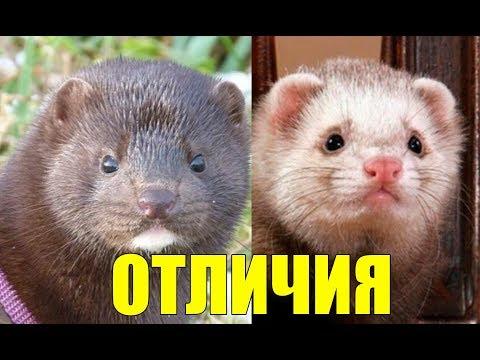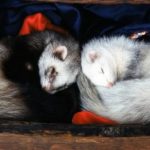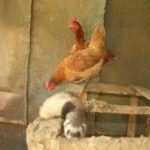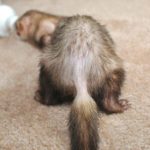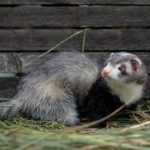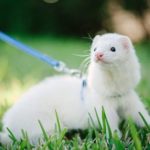Over time, people increase the number of domesticated animals. Breeders are working to suppress aggression in predators. The ferret is becoming an increasingly desirable pet due to its friendly and lively disposition. But it is easy to confuse it with a weasel if you see the animal only in a picture and have no idea even about its real size. Find out the differences between a weasel and a ferret and how to protect other pets from them.
What is the difference between a weasel and a ferret?
Both animals are predators from the mustelidae family, a genus of ferrets. Weasel is the smallest representative among such animals.Its parameters:
| Characteristics | Gender weasel | |
| Female | Male | |
| Weight | 50-120 g | 60-250 g |
| Body length | 115-215 mm | 160-260 mm |
| Tail length | 15-65 mm | 10-85 mm |
| Jump length | 25-30 cm | 30 cm |
| Track size | 1.5×1 cm | 2.5×2 cm |
The weasel's brown back contrasts with its white chest and belly. In the northern regions, after molting in the winter, the animal becomes pure white.
Weasels feed on small rodents, frogs, snakes and anything that is small and moving. The number of broods directly depends on the amount of food. In years with an abundance of rodents, weasels rut in both spring and summer.
If circumstances change with food, the second pregnancy freezes until the weather warms up next year. In March, fetal development continues.
3 species of wild ferret live in Eurasia and North America. In Russia, only 2 species are almost universally distributed: dark forest and light steppe. Their parameters:
| Characteristics | Ferret gender | |
| Female | Male | |
| Weight | 1-1.3 kg | 1.2-1.5 kg |
| Body length | 30-40 cm | 40-50 cm |
| Tail length | 8-13 cm | 10-15 cm |
| Jump length | 40-60 cm | 45-65 cm |
| Track size | 3.5×2.5 cm | 4×3 cm |
Ferrets have long been domesticated, and their colors vary:
- completely dark fur, white only at the nose and lips;
- dark with white paws, frill on chest and area around mouth and nose; there is a light area of fur between the ears and eyes;
- body and head light; neck and chest, tail covering the edges of the buttocks are dark;
- white head and golden chocolate-colored body and tail;
- white chest and light muzzle with spots of the main color (milk chocolate), which is evenly spread throughout the body and tail;
- chocolate color mixed with white, except for white paws and head;
- reddish-brown tail and paws with the same guard hairs throughout the body; the head is white, as is the undercoat;
- white chest and paws from feet to middle joint; white undercoat with dark guard hair and completely dark rump and tail;
- white fur with black spots like a Dalmatian;
- white color and black eyes.
The wild animal is brown on top, the tips of the hairs are black. Legs, belly, tail are grayish-black. The lips, edges of the ears, the arch running from the eyebrow along the cheekbone are white, the rest of the muzzle is dark. Ferrets leave a trail with distinct claw marks. The animals feed on small and medium-sized rodents, insects, birds, and eggs. At home, they produce offspring 2 times a year.
Differences between a ferret and a marten
The marten does not have a white patch on its face around the mouth and nose and round ears. She is larger.
| Characteristics | Gender of marten | |
| Female | Male | |
| Weight | 0.5-1.3 kg | 0.8-1.8 kg |
| Body length | 40-60 cm | 60-70 cm |
| Tail length | 16-23 cm | 20-28 cm |
| Jump length | 70-130 cm | 90-150 cm |
| Tree jump length | Up to 4 m | Up to 4 m |
| Track size | 4×2.5 cm | 5×4 cm |
Unlike the animals described above, the marten lives in hollows, often climbs trees, and does this no worse than the squirrel, which it hunts. The animal's fur is brown all over its body, except for its orange-white chest, which looks brighter in summer than in winter. The victims of the marten are rodents and birds that are larger in comparison with those that relatives in the family feed on.
How to distinguish animals when purchasing
All mustelids have a thin, very flexible, elongated body. They move in leaps and bounds and, if necessary, climb trees. But you can distinguish the animals. You need to pay attention to the color, size and relative length of the tail. Weasels and ferrets have small, round ears.
The marten is distinguished from them at first sight: the shape of its ears is completely different.Her ears have the most common form, like those of most animals: a tent with a sharp top. In weasels and ferrets, the top point of the ear, in the form of an even semicircle, rises quite a bit above the head.
It would be impossible for an ordinary citizen to distinguish this couple if it were not for the small size of the weasel’s body in comparison with the size of its relative and the stable color characteristic of all representatives of the smallest predator on the planet. Red-brown top and snow-white bottom with a clearly visible division between the colors, without any shading or halftones.
The danger is that the weasel, due to its smaller size, can be passed off as a baby ferret. The danger signal is a brown back and light underparts, and in winter - a pure white color. An animal of the snow color you like does not have to be rejected. It can match the size of an adult ferret. It will be an albino with red eyes or a “snow white” with black eyes. In addition, if you pick up an animal and it turns out to be affectionate and calm, you are guaranteed to have found the right specimen. But being in a store or at a market is stressful for an animal, so color and size are the best guide.
How to protect your chicken coop from predators
During winter hunger, all mustelids, if possible, settle near populated areas or right next to livestock buildings. The weasel is the most terrible predator for people, as it “cuts” birds or rabbits in reserve.
For security purposes, owners are recommended to install repellers with an ultrasonic signal or infrared radiation in chicken coops and barns.An excellent result is obtained by embedding a metal mesh into the wall with cement from 50 cm in height to the ground. The door is covered with iron.

